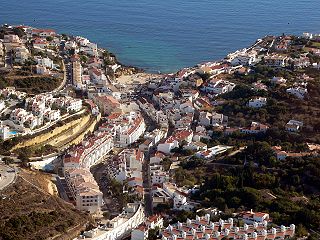
Carvoeiro is a town and a former civil parish in the municipality (concelho) of Lagoa, Algarve, Portugal. In 2013, the parish merged into the new parish Lagoa e Carvoeiro. The population in 2011 was 2,721, in an area of 11.66 km². It is located about 5 kilometres (3.1 mi) south of Lagoa.

Azulejo is a form of Portuguese and Spanish painted tin-glazed ceramic tilework. Azulejos are found on the interior and exterior of churches, palaces, ordinary houses, schools, and nowadays, restaurants, bars and even railways or subway stations. They are an ornamental art form, but also had a specific functional capacity like temperature control in homes.
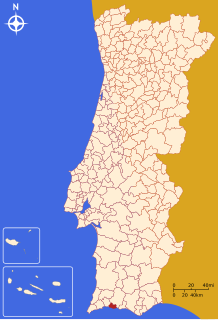
Lagoa is a town in the former-district of Faro, in the Portuguese region of the Algarve. The population in 2011 was 22,975, in an area of 88.25 km². Its urban population is 6,100 inhabitants.

Senhora das Dores Church is a Roman Catholic church in Póvoa de Varzim, Portugal. It is located in Largo das Dores square, in the old town of Póvoa de Varzim, and is part of the parish of Matriz. The church is dedicated to Our Lady of Sorrows, Nossa Senhora das Dores in Portuguese.

The Church of São Lourenço is a Church in the civil parish of Almancil, in the municipality of Loulé in the Portuguese Algarve.

Guia is a civil parish in the Portuguese municipality of Albufeira in the Algarve, 5 kilometres (3.1 mi) from the coast. The population in 2011 was 4,376, in an area of 26.80 km².

Alte is a village and civil parish in the municipality of Loulé, in the Algarve region in the south of Portugal. The population in 2011 was 1,997, in an area of 94.33 km².
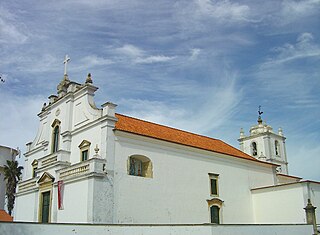
The Church of Our Lady of Light is a church situated in civil parish of Lagoa and Carvoeiro, in the municipality of Lagoa, in the Portuguese Algarve region, situated in the urban centre.
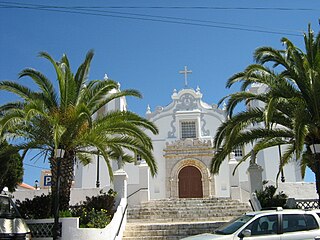
The Church of Saint James the Great is the principal church, in the civil parish of Estômbar in the municipality of Lagoa in the Algarve. Situated in the heart of the town, the church was consecrated to the invocation of Saint James, son of Zebedee.

Porches Pottery is a producer of hand-painted pottery in the town of Porches, in the Algarve region of Portugal. The pottery was founded in 1968 by artists Patrick Swift and Lima de Freitas, in order to revive a traditional Algarve pottery industry that was rapidly dying out in favour of more modern techniques. Swift and de Freitas chose Porches for its history as a pottery centre, dating back for many centuries, and for its clay pits.
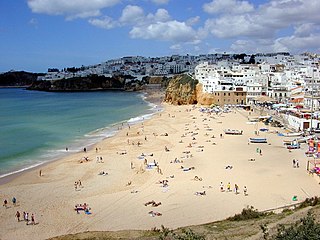
Albufeira is a city, seat and municipality in the district of Faro, in the southernmost Portuguese region of the Algarve. The municipality population in 2011 was 40,828, in an area of 140.66 square kilometres. The city proper had a population of 13,646 in 2001. It is 250 kilometres (160 mi) from Lisbon, and is within close proximity of Paderne Castle. Lagos is located 30 kilometres (19 mi) to the west, and Faro 45 kilometres (28 mi) to the south-east. A tourist destination, Albufeira expands to approximately 300,000 residents during the summer and during the Christmas and New Year celebrations, owing to the number of hotels and lodgings in the district, that includes marina facilities, golf courses, restaurants and bars for the annual flood of visitors.
The Church of the Lóios is a 15th church civil parish of Évora, municipality of Évora, in the Portuguese Alentejo.

The Church of Porto Covo is Baroque and Neoclassic church in the civil parish, municipality of Sines, in the Atlantic coast of the Portuguese Alentejo. The church's austere lines is a morphological hybridization of the styles employed during the reign of Queen Maria I. In the widespread typology of regional architecture, the Baroque elements are evident in the lintels and trim curves, framed in a composition that is, generally, more rigid then in the gable design.

The architecture of Póvoa de Varzim, in Portugal, demonstrates a broad variety of architectural styles over its thousand years of history. 11th-century Romanesque, 16th-century Mannerism, 18th-century Baroque, late 18th-century neoclassicism, early 20th-century Portuguese modernism and late 20th- to early 21st-century contemporary architectural styles and more are all represented in Póvoa de Varzim. As a whole it represents a rich eclectic tradition and innovation shaped by the people, their beliefs and economy.

A Church of São João Evangelista, or Carmelite Church of Aveiro, is an 18th-century church in the Praça Marquês de Pombal, in the civil parish of Glória e Vera Cruz, in the Portuguese municipality of Aveiro. It was declared a national monument in 1910.
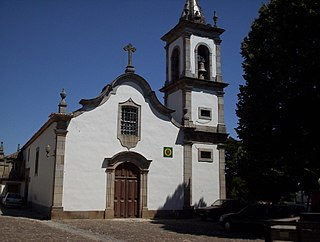
The Church of São Luís is a Latin Catholic Baroque church and former cathedral in the civil parish of Pinhel, in the municipality of the same name, Portuguese district of Guarda.
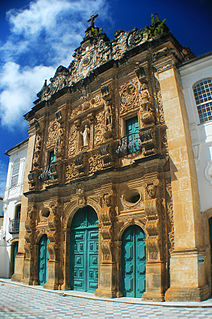
The Church of the Third Order of Saint Francis is an 18th-century Roman Catholic church in Salvador, Bahia, Brazil and seat of the Third Order of Saint Francis in Brazil. The church is one of the main elements of the Historic Center of Salvador and lies within the UNESCO World Heritage Site of the city. It was listed as a historic structure by National Institute of Historic and Artistic Heritage (IPHAN) in 1941. The church was constructed as an annex to the São Francisco Church and Convent. It is noted for its distinctive Plateresque-style façade, an example unique in Brazil. The writer Jorge Amado called the façade of the Third Order church "magnificent."

The Parish Church of Our Lady of Pilar is an 18th-century Roman Catholic church located in Salvador, Bahia, Brazil. It includes a cemetery, constructed in the Neoclassical parallel to the nave of the church. The interior of the church has an extensive set of azulejo tiles in the rococo style. The historian Carlos Ott dated them to the late 18th century, and stated that they appear to be the work of the Juncal workshop in Portugal. The stonework of the church is in lioz stone, imported from Lisbon at great expense. The art historian Germain Bazin describes the church as a "refinement of forms", due to its long, narrow nave and lack of corridors in the nave.
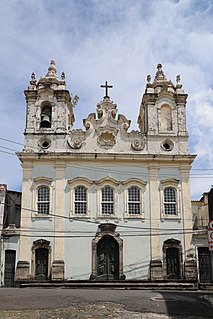
The Church of the Third Order of the Blessed Virgin Mary of Our Lady of the Conception of the Mulatto Brothers is an 18th-century Roman Catholic church and former convent in Salvador, Bahia, Brazil. The church was constructed in a neighborhood formerly occupied by mixed-race and Afro-Brazilian artisans. The exterior of the church has an elaborate roccoco pediment and towers; the interior of the church has a Baroque-style ceiling painting in the nave and neoclassical side altars and chancel. The name of the church, boqueirão, refers to a large slope and trench constructed between the high city and low city of Salvador; it served as a defense of the city against foreign invasion. It was listed as a historic structure by the National Historic and Artistic Heritage Institute in 1951.

The Retreat and Church of Our Lady of Humility is a 19th-century Roman Catholic church and women's religious retreat located in Santo Amaro, Bahia, Brazil. It is dedicated to Our Lady of Humility and covers 1,817 square metres (19,560 sq ft). The retreat and church consists of an architectural ensemble of a chapel, a retreat, a seminary, parsonage, forecourt, and side garden. It was listed as a historic structure of the State of Bahia by the IPAC in 1986.




















